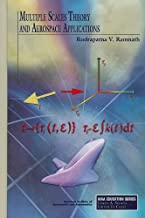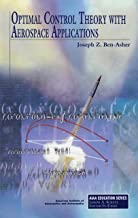Small Unmanned Fixed-wing Aircraft Design: A Practical Approach
Original price was: ₹9,630.70.₹7,704.56Current price is: ₹7,704.56.
ISBN: 9781119406297
Author/Editor: Andrew J Keane
Publisher: John Wiley
Year: 2017
1 in stock (can be backordered)
Description
Small Unmanned Fixed-wing Aircraft Design is the essential guide to designing, building and testing fixed wing UAVs (or drones). It deals with aircraft from two to 150 kg in weight and is based on the first-hand experiences of the world renowned UAV team at the UK s University of Southampton. The book covers both the practical aspects of designing, manufacturing and flight testing and outlines and the essential calculations needed to underpin successful designs. It describes the entire process of UAV design from requirements definition to configuration layout and sizing, through preliminary design and analysis using simple panel codes and spreadsheets to full CFD and FEA models and on to detailed design with parametric CAD tools. Its focus is on modest cost approaches that draw heavily on the latest digital design and manufacturing methods, including a strong emphasis on utilizing off-the-shelf components, low cost analysis, automated geometry modelling and 3D printing. It deliberately avoids a deep theoretical coverage of aerodynamics or structural mechanics; rather it provides a design team with sufficient insights and guidance to get the essentials undertaken more pragmatically.
The book contains many all-colour illustrations of the dozens of aircraft built by the authors and their students over the last ten years giving much detailed information on what works best. It is predominantly aimed at under-graduate and MSc level student design and build projects, but will be of interest to anyone engaged in the practical problems of getting quite complex unmanned aircraft flying. It should also appeal to the more sophisticated aero-modeller and those engaged on research based around fixed wing UAVs.
Additional information
| Weight | 1.08 kg |
|---|
Product Properties
| Year of Publication | 2017 |
|---|---|
| Table of Contents | 1 Background of the Smart Grid 1 1.1 Motivations and Objectives of the Smart Grid 1 1.1.1 Better Renewable Energy Resource Adaption 2 1.1.2 Grid Operation Efficiency Advancement 3 1.1.3 Grid Reliability and Security Improvement 4 1.2 Smart Grid Communications Architecture 5 1.2.1 Conceptual Domain Model 6 1.2.2 Two-Way Communications Network 7 1.3 Applications and Requirements 9 1.3.1 Demand Response 9 1.3.2 Advanced Metering Infrastructure 10 1.3.3 Wide-Area Situational Awareness and Wide-Area Monitoring Systems 11 1.3.4 Communication Networks and Cybersecurity 12 1.4 The Rest of the Book 13 2 Smart Grid Communication Infrastructures 15 2.1 An ICT Framework for the Smart Grid 15 2.1.1 Roles and Benefits of an ICT Framework 15 2.1.2 An Overview of the Proposed ICT Framework 16 2.2 Entities in the ICT Framework 18 2.2.1 Internal Data Collectors 18 2.2.2 Control Centers 20 2.2.3 Power Generators 22 2.2.4 External Data Sources 23 2.3 Communication Networks and Technologies 23 2.3.1 Private and Public Networks 23 2.3.2 Communication Technologies 24 2.4 Data Communication Requirements 30 2.4.1 Latency and Bandwidth 31 2.4.2 Interoperability 32 2.4.3 Scalability 32 2.4.4 Security 32 2.5 Summary 33 3 Self-Sustaining Wireless Neighborhood-Area Network Design 35 3.1 Overview of the Proposed NAN 35 3.1.1 Background and Motivation of a Self-Sustaining Wireless NAN 35 3.1.2 Structure of the Proposed NAN 37 3.2 Preliminaries 38 3.2.1 Charging Rate Estimate 39 3.2.2 Battery-Related Issues 40 3.2.3 Path Loss Model 42 3.3 Problem Formulations and Solutions in the NAN Design 44 3.3.1 The Cost Minimization Problem 44 3.3.2 Optimal Number of Gateways 48 3.3.3 Geographical Deployment Problem for Gateway DAPs 51 3.3.4 Global Uplink Transmission Power Efficiency 54 3.4 Numerical Results 56 3.4.1 Evaluation of the Optimal Number of Gateways 56 3.4.2 Evaluation of the Global Power Efficiency 56 3.4.3 Evaluation of the Global Uplink Transmission Rates 58 3.4.4 Evaluation of the Global Power Consumption 59 3.4.5 Evaluation of the Minimum Cost Problem 59 3.5 Case Study 63 3.6 Summary 65 4 Reliable Energy-Efficient Uplink Transmission Power Control Scheme in NAN 67 4.1 Background and Related Work 67 4.1.1 Motivations and Background 67 4.1.2 Related Work 69 4.2 System Model 70 4.3 Preliminaries 71 4.3.1 Mathematical Formulation 72 4.3.2 Energy Efficiency Utility Function 73 4.4 Hierarchical Uplink Transmission Power Control Scheme 75 4.4.1 DGD Level Game 76 4.4.2 BGD Level Game 77 4.5 Analysis of the Proposed Schemes 78 4.5.1 Estimation of B and D 78 4.5.2 Analysis of the Proposed Stackelberg Game 80 4.5.3 Algorithms to Approach NE and SE 84 4.6 Numerical Results 85 4.6.1 Simulation Settings 85 4.6.2 Estimate of D and B 86 4.6.3 Data Rate Reliability Evaluation 87 4.6.4 Evaluation of the Proposed Algorithms to Achieve NE and SE 88 4.7 Summary 90 5 Design and Analysis of a Wireless Monitoring Network for Transmission Lines in the Smart Grid 91 5.1 Background and Related Work 91 5.1.1 Background and Motivation 91 5.1.2 Related Work 93 5.2 Network Model 94 5.3 Problem Formulation 96 5.4 Proposed Power Allocation Schemes 99 5.4.1 Minimizing Total Power Usage 100 5.4.2 Maximizing Power Efficiency 101 5.4.3 Uniform Delay 104 5.4.4 Uniform Transmission Rate 104 5.5 Distributed Power Allocation Schemes 105 5.6 Numerical Results and A Case Study 107 5.6.1 Simulation Settings 107 5.6.2 Comparison of the Centralized Schemes 108 5.6.3 Case Study 113 5.7 Summary 113 6 A Real-Time Information-Based Demand-Side Management System 115 6.1 Background and Related Work 115 6.1.1 Background 115 6.1.2 Related Work 117 6.2 System Model 118 6.2.1 The Demand-Side Power Management System 118 6.2.2 Mathematical Modeling 120 6.2.3 Energy Cost and Unit Price 122 6.3 Centralized DR Approaches 124 6.3.1 Minimize Peak-to-Average Ratio 124 6.3.2 Minimize Total Cost of Power Generation 125 6.4 Game Theoretical Approaches 128 6.4.1 Formulated Game 128 6.4.2 Game Theoretical Approach 1: Locally Computed Smart Pricing 129 6.4.3 Game Theoretical Approach 2: Semifixed Smart Pricing 131 6.4.4 Mixed Approach: Mixed GA1 and GA2 132 6.5 Precision and Truthfulness of the Proposed DR System 132 6.6 Numerical and Simulation Results 132 6.6.1 Settings 132 6.6.2 Comparison of P1, P2 and GA1 135 6.6.3 Comparison of Different Distributed Approaches 136 6.6.4 The Impact from Energy Storage Unit 141 6.6.5 The Impact from Increasing Renewable Energy 143 6.7 Summary 145 7 Intelligent Charging for Electric Vehicles-Scheduling in Battery Exchanges Stations 147 7.1 Background and Related Work 147 7.1.1 Background and Overview 147 7.1.2 Related Work 149 7.2 System Model 150 7.2.1 Overview of the Studied System 150 7.2.2 Mathematical Formulation 151 7.2.3 Customer Estimation 152 7.3 Load Scheduling Schemes for BESs 154 7.3.1 Constraints for a BES si 154 7.3.2 Minimizing PAR: Problem Formulation and Analysis 156 7.3.3 Problem Formulation and Analysis for Minimizing Costs 156 7.3.4 Game Theoretical Approach 159 7.4 Simulation Analysis and Results 161 7.4.1 Settings for the Simulations 161 7.4.2 Impact of the Proposed DSM on PAR 163 7.4.3 Evaluation of BESs Equipment Settings 164 7.4.3.1 Number of Charging Ports 164 7.4.3.2 Maximum Number of Fully Charged Batteries 164 7.4.3.3 Preparation at the Beginning of Each Day 165 7.4.3.4 Impact on PAR from BESs 166 7.4.4 Evaluations of the Game Theoretical Approach 167 7.5 Summary 169 8 Big Data Analytics and Cloud Computing in the Smart Grid 171 8.1 Background and Motivation 171 8.1.1 Big Data Era 171 8.1.2 The Smart Grid and Big Data 173 8.2 Pricing and Energy Forecasts in Demand Response 174 8.2.1 An Overview of Pricing and Energy Forecasts 174 8.2.2 A Case Study of Energy Forecasts 176 8.3 Attack Detection 179 8.3.1 An Overview of Attack Detection in the Smart Grid 179 8.3.2 Current Problems and Techniques 180 8.4 Cloud Computing in the Smart Grid 182 8.4.1 Basics of Cloud Computing 182 8.4.2 Advantages of Cloud Computing in the Smart Grid 183 8.4.3 A Cloud Computing Architecture for the Smart Grid 184 8.5 Summary 185 9 A Secure Data Learning Scheme for Big Data Applications in the Smart Grid 187 9.1 Background and Related Work 187 9.1.1 Motivation and Background 187 9.1.2 Related Work 189 9.2 Preliminaries 190 9.2.1 Classic Centralized Learning Scheme 190 9.2.2 Supervised Learning Models 191 9.2.2.1 Supervised Regression Learning Model 191 9.2.2.2 Regularization Term 191 9.2.3 Security Model 192 9.3 Secure Data Learning Scheme 193 9.3.1 Data Learning Scheme 193 9.3.2 The Proposed Security Scheme 194 9.3.2.1 Privacy Scheme 194 9.3.2.2 Identity Protection 195 9.3.3 Analysis of the Learning Process 197 9.3.4 Analysis of the Security 197 9.4 Smart Metering Data Set Analysis-A Case Study 198 9.4.1 Smart Grid AMI and Metering Data Set 198 9.4.2 Regression Study 200 9.5 Conclusion and Future Work 203 10 Security Challenges in the Smart Grid Communication Infrastructure 205 10.1 General Security Challenges 205 10.1.1 Technical Requirements 205 10.1.2 Information Security Domains 207 10.1.3 Standards and Interoperability 207 10.2 Logical Security Architecture 207 10.2.1 Key Concepts and Assumptions 207 10.2.2 Logical Interface Categories 209 10.3 Network Security Requirements 210 10.3.1 Utility-Owned Private Networks 210 10.3.2 Public Networks in the Smart Grid 212 10.4 Classification of Attacks 213 10.4.1 Component-Based Attacks 213 10.4.2 Protocol-Based Attacks 214 10.5 Existing Security Solutions 215 10.6 Standardization and Regulation 216 10.6.1 Commissions and Considerations 217 10.6.2 Selected Standards 217 10.7 Summary 219 11 Security Schemes for AMI Private Networks 221 11.1 Preliminaries 221 11.1.1 Security Services 221 11.1.2 Security Mechanisms 222 11.1.3 Notations of the Keys Used in This Chapter 223 11.2 Initial Authentication 223 11.2.1 An Overview of the Proposed Authentication Process 223 11.2.1.1 DAP Authentication Process 224 11.2.1.2 Smart Meter Authentication Process 225 11.2.2 The Authentication Handshake Protocol 226 11.2.3 Security Analysis 229 11.3 Proposed Security Protocol in Uplink Transmissions 230 11.3.1 Single-Traffic Uplink Encryption 231 11.3.2 Multiple-Traffic Uplink Encryption 232 11.3.3 Decryption Process in Uplink Transmissions 233 11.3.4 Security Analysis 235 11.4 Proposed Security Protocol in Downlink Transmissions 235 11.4.1 Broadcast Control Message Encryption 236 11.4.2 One-to-One Control Message Encryption 236 11.4.3 Security Analysis 237 11.5 Domain Secrets Update 238 11.5.1 AS Public/Private Keys Update 238 11.5.2 Active Secret Key Update 238 11.5.3 Preshared Secret Key Update 239 11.6 Summary 239 12 Security Schemes for Smart Grid Communications over Public Networks 241 12.1 Overview of the Proposed Security Schemes 241 12.1.1 Background and Motivation 241 12.1.2 Applications of the Proposed Security Schemes in the Smart Grid 242 12.2 Proposed ID-Based Scheme 244 12.2.1 Preliminaries 244 12.2.2 Identity-Based Signcryption 245 12.2.2.1 Setup 245 12.2.2.2 Keygen 245 12.2.2.3 Signcryption 246 12.2.2.4 Decryption 246 12.2.2.5 Verification 246 12.2.3 Consistency of the Proposed IBSC Scheme 247 12.2.4 Identity-Based Signature 247 12.2.4.1 Signature 248 12.2.4.2 Verification 248 12.2.5 Key Distribution and Symmetrical Cryptography 248 12.3 Single Proxy Signing Rights Delegation 249 12.3.1 Certificate Distribution by the Local Control Center 249 12.3.2 Signing Rights Delegation by the PKG 250 12.3.3 Single Proxy Signature 250 12.4 Group Proxy Signing Rights Delegation 251 12.4.1 Certificate Distribution 251 12.4.2 Partial Signature 251 12.4.3 Group Signature 251 12.5 Security Analysis of the Proposed Schemes 252 12.5.1 Assumptions for Security Analysis 252 12.5.2 Identity-Based Encryption Security 253 12.5.2.1 Security Model 253 12.5.2.2 Security Analysis 253 12.5.3 Identity-Based Signature Security 255 12.5.3.1 Security Models 255 12.5.3.2 Security Analysis 256 12.6 Performance Analysis of the Proposed Schemes 258 12.6.1 Computational Complexity of the Proposed Schemes 258 12.6.2 Choosing Bilinear Paring Functions 259 12.6.3 Numerical Results 260 12.7 Conclusion 261 13 Open Issues and Possible Future Research Directions 263 13.1 Efficient and Secure Cloud Services and Big Data Analytics 263 13.2 Quality-of-Service Framework 263 13.3 Optimal Network Design 264 13.4 Better Involvement of Green Energy 265 13.5 Need for Secure Communication Network Infrastructure 265 13.6 Electrical Vehicles 265 |
| Author | Andrew J Keane |
| ISBN/ISSN | 9781119406297 |
| Binding | Hardback |
| Edition | 1 |
| Publisher | John Wiley |
You must be logged in to post a review.






Reviews
There are no reviews yet.